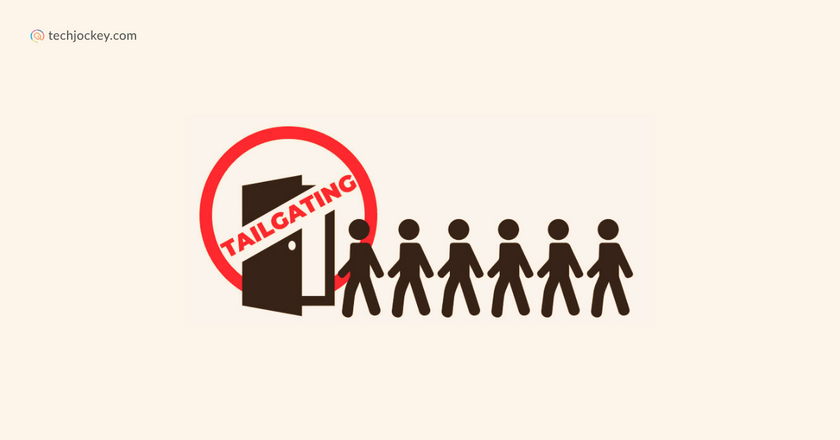How Tailgating Attacks Happen: Real-World Cases and How to Stop Them?

While much attention is given to digital security today, physical breaches still pose a huge threat to our organizational defences. Standing out among these, the tailgating attack, for one, bypasses security controls like they mean nothing.
Despite making investments in robust cybersecurity software and access control systems, companies find themselves at the mercy of attackers who exploit human behaviour to access off-limits locations. It is thus crucial for each and every business to understand tailgating in cybersecurity and how it works, so they can remain protected against its vicious attacks, one unauthorized interloper at a time.
What is Tailgating Attack In Cybersecurity?
When an unauthorized person tails an authorized one into a restricted area without their knowledge, it is called a tailgating attack. To do the same, they take advantage of the sundry traits of human nature, including politeness, distraction, or reluctance to speak up in front of others.
Unlike hacking, which targets digital systems, tailgating is a form of social engineering attack that manipulates people rather than technology.
Tailgating Attack vs. Piggybacking
People often confuse piggybacking with a tailgating attack, even though the two are substantially different. Here’s exactly how they differ…
| Aspect | Tailgating Attack | Piggybacking |
|---|---|---|
| Definition | An authorized user knowingly allows an unauthorized person to enter | Authorized user knowingly allows an unauthorized person to enter |
| Method | Exploits distraction, politeness, or social norms | Involves permission from the authorized user |
| Example | When a stranger slips in behind an employee | The unauthorized person follows an authorized user without their knowledge |
While a tailgating attack relies on deception, piggybacking requires active cooperation from someone who has legitimate access. Though both are risky, tailgating is especially bad because it happens without the person in charge knowing.
How Does a Tailgating Attack Work?
Here’s how a typical tailgating attack unfolds…
- Observation: The attacker keeps a close watch on the target environment, finds access points, understands the busiest times, and makes note of how employees operate. They also seek doors with access control systems, including card readers or biometric scanners.
- Approach: They then position themselves near a secure entrance, waiting for an employee to arrive.
- Entry: As and when an authorized person unlocks the door, the attacker quietly follows and gets in before the door closes. This can either be done subtly or by distracting or engaging the employee in a conversation.
- Deception: In several cases, the attacker could carry packages or wear uniforms to blend in. They can tell you they forgot their badge or pretend to be new recruits without one.
- Exploitation: Once they are inside, they can access sensitive areas, steal information, install malicious devices, or cause physical damage.

Avast Essential Business Security
Starting Price
₹ 2604.00 excl. GST
Examples of Tailgating Attacks
To understand the dangers of a tailgating attack, let’s look at some real-world examples that elucidate how it can occur…
1. The Delivery Disguise
Most of the time, the attackers dress up as delivery personnel and carry packages with them. Eager to be useful or not wanting to delay the delivery, some employees leave the door open for them before checking their badges. This helps them infiltrate secure areas to steal important documents, access systems, or plant malicious devices.
2. The Forgotten Badge
This is when an intruder waits near the main entrance, and when an employee arrives, exclaims their badge isn’t working. Since the employee feels sorry for the person or doesn’t wish to argue, they let the person in. This simple act of kindness can cause serious damage, such as loss of private information or damage to major systems.

SentinelOne
Starting Price
Price on Request
3. Digital Tailgating
A tailgating attack isn’t just limited to physical spaces. In a digital setting, for instance, an attacker could gain access to an unlocked workstation in a secure place or use tricks to get passwords out of an employee. Once inside the network, he/she can freely move around to access protected files or release malicious software.
4. Exploiting Open Wi-Fi
After tailgating into a building, an attacker can connect to an unsecured corporate Wi-Fi network. Using it, they can intercept communications, access internal systems, or launch further cyberattacks. This form of tailgating attack sheds light on how physical and digital security are deeply interconnected.
5. Conference Room Intruder
In a crowded conference or meeting, an attacker can easily hide in the group and get access to a restricted section. He/she might pretend to be a participant or vendor to escape notice. As soon as they gain access, they may participate in private conversations, steal computer equipment, or gather data critical for future attacks.
Risks & Dangers of a Tailgating Attack
The consequences of tailgating in cybersecurity can be severe. Some of the primary risks associated with a tailgating attack are thus mentioned below to keep you duly informed and aware…
- Data Breaches: Gaining unauthorized access to secure areas can result in the theft of crucial documents, details about customers, or intellectual property. If your company experiences a data breach, you might face formal penalties, possible lawsuits, and lose the trust of your clients.
- Malware Installation: Attackers can install malware on company devices, which can lead to ransomware attacks, loss of confidential information, or disruption of business operations.
- Physical Theft or Damage: Equipment, documents, or other assets may be stolen. This can include laptops, servers, or even physical records containing sensitive information.
- Compliance Violations: Many industries adhere to strict regulations regarding access control and data protection. However, a tailgating attack can hamper their compliance, resulting in fines or loss of certification.
- Reputational Damage: The relationship that a business shares with its customers, partners, and stakeholders can take a severe hit owing to a security breach. This damage to an organization’s reputation can last for a lifetime.
- Insider Threats: A tailgating attack can also lead to insider threats if internal personnel join hands with the attackers, compromising security further.
How to Detect & Prevent a Tailgating Attack?
Preventing a tailgating attack is necessary to keep an organization up and running. Here are some of the most effective strategies that you can adhere to in order to achieve the same…
1. Access Control Systems
Businesses can install access control systems like keycards, biometric scanners, and turnstiles to prevent unlawful access and only let authorized personnel check in. These systems, however, should be supported by careful enforcement and regular audits to ensure they remain effective at all times.

ESSL Door Access Control
Starting Price
Price on Request
2. Tailgating Detection Systems
The market is filled with sundry tailgating detection systems that make use of sensors, cameras, and analytics to keep a tab on entry points. Businesses can get them installed to keep track of the number of people who enter on a single authentication. If it’s more than one, these automatically alert the security personnel, enabling immediate response.
3. Visitor Management Software
With robust visitor management software, organizations can manage and monitor all guest visitors to the premises. These tools temporarily assign badges, make note of logins and exit times, and ensure every person is accounted for. Owing to this, it gets easier for businesses to identify unauthorized individuals and restrict their access.
You can read more about their types, features, and benefits in our blog on Effective Visitor Systems for Managing Physical Security Risks.

truMe VMS
Starting Price
Price on Request
4. Gate Pass Management Software
Gate pass management software automates the process of issuing, tracking, and validating gate passes for visitors. Since all guests are thoroughly checked and documented, it becomes much less likely that unauthorized individuals will get past security.

Envision Gate Management
Starting Price
Price on Request
5. Employee Training & Awareness
It is important to train your employees when it comes to effectively evading tailgating in cybersecurity. They should be taught not to hold the door open for someone who doesn’t have a valid credential to showcase. They should also be encouraged to report suspicious behaviour or individuals immediately, so attempts at any kind of cyber-attack can be averted in time.
6. Security Policies & Culture
Businesses must develop and enforce security policies related to access control, and all employees should realize why they are important. If people in a community are willing and expected to challenge strangers, security will be more effective.
7. Physical Security Measures
The use of security doors, turnstiles, mantraps, and physical security guards would give extra protection to your organization. With regular audits and security drills, you can discover the weaknesses of your physical security procedures and rectify them in time.

ThreatCop
Starting Price
Price on Request
8. Integration with Cyber Security Software
Link your physical security with cybersecurity software to help detect and deal with security incidents more effectively. For instance, if a tailgating alert comes up, cybersecurity teams can divert their complete attention to the network activity in that part of the system.
Conclusion
A tailgating attack is one of the most common and persistent threats in today’s world. To evade it, businesses need a workforce that is aware and supported by strong rules and security tools. They are also required to treat tailgating attack prevention as an essential element of their security plan.
All this, so basic courtesies don’t lead to major security failures and reputational damages for all the stakeholders involved.
Yashika Aneja is a Senior Content Writer at Techjockey, with over 5 years of experience in content creation and management. From writing about normal everyday affairs to profound fact-based stories on wide-ranging themes, including environment, technology, education, politics, social media, travel, lifestyle so on and so forth, she... Read more




























